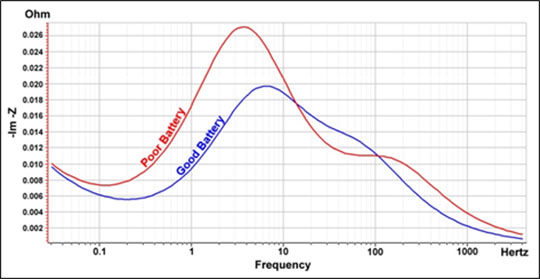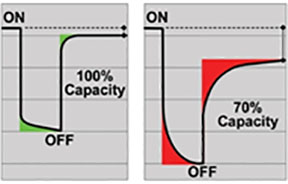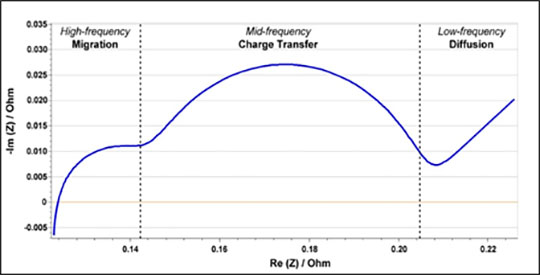Contributed Commentary by Isidor Buchmann, CEO & Founder, Cadex Electronics, Inc.
A battery resembles a living organism that cannot be measured; only estimated by diagnostics similar to a doctor examining a patient. The accuracy of rapid-testing varies according to symptoms that change with state-of-charge (SoC), agitation after charge and discharge, temperature and storage. A rapid-test must distinguish between a good battery that is partially charged and a weak pack that is fully charged. Both will deliver similar runtimes in the hands of the user but have different performance levels.
A widely used performance analysis is coulomb counting in which in-and-out-flowing energies are measured. Coulomb counting goes back 250 years when Charles-Augustin de Coulomb first established the “Coulomb Rule.” Elegant in concept, coulomb counting has its own problem by losing accuracy when the battery is randomly charged and discharged. State-of-health (SoH) estimation by a digital solution is incomplete without including the chemical battery.
The leading health indicator of a battery is capacity. Capacity represents energy storage, a quality that gradually and permanently fades with use. Other characteristics responsible for SoH are internal resistance that governs load current and self-discharge that examines mechanical integrity. All three characteristics must be met to give a battery a clean bill of health.
Estimating the capacity of the chemical battery on the fly is most complex. This involves algorithms and matrices that serve as lookup tables similar to letter or face recognition. Modern rapid-test methods move towards advanced machine learning in capturing the many moods of a battery.
Here is a summary of simple to complex test methods to examine batteries.
Voltage: Reveals SoC. Capacity estimation is not possible.
Ohmic Test: Measures internal battery resistance to verify loading characteristics and to identify fault conditions. Resistance readings do not correlate with capacity. The ohmic test is also known as an impedance test (Z).
Full Cycle: Reads the capacity of the chemical battery with a charge/discharge/charge cycle. The results are accurate but a battery must often be removed from service and the testing times take hours.
Rapid-Test: Most rapid-test methods are based on time domain or frequency domain. Time domain excites the battery with pulses to observe ion-flow of Li-ion batteries. Frequency domain scans the battery with multiple frequencies to generate a Nyquist plot for analysis. Both methods require complex algorithms with parameters or matrices that serve as lookup tables.
BMS: Battery Management Systems estimate SoC by monitoring voltage, current and temperature. Some BMS for Li-ion also counts coulombs. A BMS can identify a battery defect but is unable to estimate capacity accurately.
Coulomb Counting: Reads in-and out flowing current. The smart battery stores the data in the Full Charge Capacity (FCC) register that can be accessed but the readings can be inaccurate if the battery is not calibrated. A full cycle corrects the tracking error.
Battery Parser: A new method to estimate capacity during charge. A proprietary filtering algorithm establishes the precise SoC; coulomb counting estimates battery capacity.
Rapid-Test Methods: No single test can capture all health indicators of a battery. Many rapid-test devices look only at voltage and internal resistance. While capacity loss of a fading NiCd or NiMH may correlate with rising internal resistance, this relationship is less evident with lithium- and lead-based batteries. Advertising capacity estimation with a tester that only measures voltage and internal resistance can be misleading. It confuses the industry into believing that complex results are attainable with simplistic methods. Resistance-based instruments will indeed identify a dying or dead battery; but so does the user.

Impedance variances are most visible below 10Hz. The horizontal scale is logarithmic to condense the frequency range. Source: Cadex Electronics
A battery is a reactive device and the method by which resistance measurements are taken matters. A DC measurement looks at pure resistive values while AC includes reactive components that provide additional information. Figure 1 represents the impedance of a good and faded Li-ion battery when scanned with AC from 0.1 Hz to 1 kHz. The strongest variances in impedance (-Imp -Z) are observed on the low frequency scale ranging between 1 Hz and 10 Hz.
It should be noted that resistive readings alone are inconclusive. No size fits all and the signatures vary with battery size and type. The results are further skewed by SoC levels, agitation and temperature. Cadex laboratories further discovered differences in how batteries are aged. What is most puzzling is why natural aging produces dissimilar signatures than artificial aging done in environmental chambers with fixed test regimes. This human-like behavior shares similarities with longevities people experience living in different global regions.
Quick-Sort Model Specific (QSMS)
QSMS observes difference in resistive values when assessing a battery with DC and AC methods. For example, the resistance of Li-ion in an 18650 cell is about 110 mOhm with DC measurement and roughly 36 mOhm with a 1,000 Hz AC signal. The variance between the two readings provides performance information when compared with battery-specific parameters that are stored in a lookup table.

The algorithm is relatively simple and the test time is short, but the logistics of creating the parameters derived from good, marginal and poor batteries adds to complexity. QSMS is one of several rapid-test methods that Cadex has developed to classify mobile phone batteries on the fly.
Electrochemical Dynamic Response (EDR)
EDR measures the mobility of ion-flow between electrodes by applying load pulses and evaluating the response time on attack and recovery. The recovery times are compared with stored parameters relating to battery performance. Figure 2 demonstrates a good battery that is firm and has a quick recovery against a weak battery that shows softness and has a sluggish recovery.
The diffusion coefficient of Li-ion differs according to active material and electrolyte additives used. EDR was developed by Cadex to rapid-test a broad range of mobile phone batteries. The technology is now being developed to test larger batteries.
Electrochemical Impedance Spectroscopy (EIS)
EIS moves rapid-testing to a higher complexity level by scanning a battery with multiple frequencies to generate a Nyquist plot. The Nyquist information is superimposed onto electrochemical models that enable the estimation of capacity, CCA and SoC non-invasively. The typical test time is 15 seconds.
The Nyquist plot is named after Harry Nyquist (1889–1976), a former engineer at Bell Laboratories. It presents the frequency response of a linear system by displaying both amplitude and phase angle on a single plot using frequency as parameter. The horizontal x axis reveals the real Ohm impedance while the vertical y axis represents the imaginary impedance. Scientists predict that battery diagnostics is gravitating toward EIS technology by combining test results with complex modeling.
Figure 3 illustrates the three domains of the Nyquist plot entitled migration on the high frequency end, charge transfer in mid-range, and diffusion on the low frequency scale.

When scanning a battery from kilohertz to millihertz, the Migration field reveals resistive qualities of a battery that represents a bird’s-eye view of the landscape. Valuable characteristics are found in the mid frequency range called Charge Transfer. This all-important domain forms a semi-circle representing the kinetics of the battery that provide SoH references. The low range dubbed Diffusion includes additional information relating to capacity but this requires long test times. Battery size directs the frequency; the larger the battery in ampere-hours, the lower the applied frequency becomes.
A rapid-test should last from a few seconds to no more than 5 minutes, but applying ultra-low frequencies prolongs time. For example, at one millihertz (mHz), one cycle takes 1,000 seconds, or 16 minutes, and several data points are required to complete the analysis. Test durations can often be shortened with clever software simulation.
Nyquist analysis is well suited to test lithium- and lead-based batteries. The multi-model electrochemical impedance spectroscopy, or Spectro™ by Cadex, is the first EIS-based application that estimates battery capacity. Capacity is the leading health indicator; CCA of a starter battery refers to the internal battery resistance that is responsible for engine cranking. In a well-maintained battery, CCA stays high while the capacity gradually decreases with use. A ‘no-start’ occurs when the capacity drops below a required capacity level to crank the engine. To eliminate surprises, a starter battery should be replaced when the capacity drops to 40 percent. The benefit of capacity estimation also becomes clear in this application.
Battery Parser
The term “parser” has been in use in computer technology to describe receiving and sorting instructional data. Cadex uses this term to define battery capacity by establishing the precise SoC with a proprietary algorithm (patent pending) and then counting the coulombs that “fill” the available space of the battery. The charge period must be long enough to attain good readings. Lab results at Cadex show higher capacity accuracies with the battery parser than what is typical with uncalibrated coulomb counting of a smart battery.
The battery parser uses advanced machine learning, algorithms that will make its way into modern battery chargers to provide quality control in batteries. This integration will promote the charger into a supervisory system with no added logistics and little extra cost. Diagnostic battery chargers make battery performance transparent by removing the “black box” syndrome, a problem that has haunted battery users for centuries.
Summary
No rapid-test can evaluate all battery symptoms. There will always be outliers to defy the test protocols. Correct predictions for batteries in service should be 9 out of 10. Outliers may include batteries that are new and have not been fully formatted, or packs that have been in storage. Low SoC also causes errors.
Capacity is the gate keeper of battery health that relates to runtime and predicts end-of-life. The term capacity is poorly understood. A battery is typically replaced when the capacity fades to 80 percent. When choosing the end-of-life thresholds, an organization should ensure that the lowest performing battery can perform the assigned duty. Revealing capacity estimation by rapid-testing or in a charger will change the way batteries are maintained. These advances will ultimately usher in an industrial revolution in batteries.
Isidor Buchmann is the founder and CEO of Cadex Electronics Inc. For three decades, Buchmann has studied the behavior of rechargeable batteries in practical, everyday applications, has written award-winning articles including the best-selling book “Batteries in a Portable World,” now in its fourth edition. Cadex specializes in the design and manufacturing of battery chargers, analyzers and monitoring devices. For more information on batteries, visit www.batteryuniversity.com; product information is on www.cadex.com.







